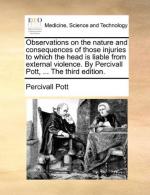|
This section contains 375 words (approx. 2 pages at 300 words per page) |
World of Health on Percival Pott
Percival Pott was a highly successful and influential 18th-century London surgeon. Pott, who was born in London, was one of the first physicians to describe many medical conditions, some of which now bear his name. Following an apprenticeship under surgeon Edward Nourse, Pott joined the staff at St. Bartholomew's Hospital, initially as an assistant, and later as a senior surgeon and professor, serving there from 1744 through 1787. Toward the end of the century, Pott had built up one of the most successful surgical practices in London. Those who knew him report that he had a kindly, charitable nature.
Disorders named after Pott include Pott's disease, which is a rare spinal condition caused by tuberculosis that eventually leads to bone disintegration and skeletal deformity (1779); Pott's puffy tumor (an abscess with associated localized headache, tenderness, and edema of the affected area (1768); and Pott's fracture (1750), which is a particular type of compound fracture of the ankle that Pott himself sustained after a fall in the street. Pott's lectures at St. Bartholomew's Hospital were well attended, not only by students but also by foreign visitors. Pott wrote extensively about his clinical observations. In 1765 he published Fractures and Dislocations, in which he identified the two conditions that now bear his name as well as many other conditions that relate to bone structure. Other writings treated various head injuries, hernia, fistula-in-ano (an abnormal channel between the lower bowel and the skin of the perineum), and hydrocele (a swelling of the scrotum). Pott also recognized a form of cancer located in the skin of the scrotum (epithelioma of the scrotum) as an occupational hazard peculiar to chimney sweeps. When one considers that Pott's contributions to medical knowledge came before the advent of anesthesia, at a time when surgeons were largely restricted to operating on the surface of the body (and avoided regions within the head, neck, or abdomen), one can begin to appreciate the genius of Pott's work. Pott was elected to the Royal Society in 1764. His published works include That Kind of Palsy of the Lower Limbs which is Frequently Found to Accompany a Curvature of the Spine (1779). His treatises on hernia (1756), head injuries (1760), hydrocele (1762), fistula in ano (1765), fractures and dislocations (1768), chimney sweep's cancer (1775), and spinal deformity (1779) are considered masterpieces.
|
This section contains 375 words (approx. 2 pages at 300 words per page) |


